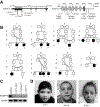Loss of Protocadherin-12 Leads to Diencephalic-Mesencephalic Junction Dysplasia Syndrome
- PMID: 30178464
- PMCID: PMC6510237
- DOI: 10.1002/ana.25327
Loss of Protocadherin-12 Leads to Diencephalic-Mesencephalic Junction Dysplasia Syndrome
Abstract
Objective: To identify causes of the autosomal-recessive malformation, diencephalic-mesencephalic junction dysplasia (DMJD) syndrome.
Methods: Eight families with DMJD were studied by whole-exome or targeted sequencing, with detailed clinical and radiological characterization. Patient-derived induced pluripotent stem cells were derived into neural precursor and endothelial cells to study gene expression.
Results: All patients showed biallelic mutations in the nonclustered protocadherin-12 (PCDH12) gene. The characteristic clinical presentation included progressive microcephaly, craniofacial dysmorphism, psychomotor disability, epilepsy, and axial hypotonia with variable appendicular spasticity. Brain imaging showed brainstem malformations and with frequent thinned corpus callosum with punctate brain calcifications, reflecting expression of PCDH12 in neural and endothelial cells. These cells showed lack of PCDH12 expression and impaired neurite outgrowth.
Interpretation: DMJD patients have biallelic mutations in PCDH12 and lack of protein expression. These patients present with characteristic microcephaly and abnormalities of white matter tracts. Such pathogenic variants predict a poor outcome as a result of brainstem malformation and evidence of white matter tract defects, and should be added to the phenotypic spectrum associated with PCDH12-related conditions. Ann Neurol 2018;84:646-655.
© 2018 American Neurological Association.
Conflict of interest statement
Potential Conflicts of Interest
Nothing to report
Figures




References
-
- Abdel Razek AA, Castillo M. Magnetic resonance imaging of malformations of midbrain-hindbrain. J Comput Assist Tomogr. 2016;40:14–25 - PubMed
-
- Madry J, Szlufik S, Koziorowski D, et al. The patient with mild diencephalic-mesencephalic junction dysplasia - Case report and review of literature. Neurol Neurochir Pol. 2017;17:30112–3 - PubMed
-
- Wu Q, Maniatis T. A striking organization of a large family of human neural cadherin-like cell adhesion genes. Cell. 1999;97:779–90 - PubMed
Publication types
MeSH terms
Substances
Grants and funding
- P30 NS047101/NS/NINDS NIH HHS/United States
- R00 NS089943/NS/NINDS NIH HHS/United States
- R01 NS048453/NS/NINDS NIH HHS/United States
- U54HG006504/NH/NIH HHS/United States
- R01 NS098004/NS/NINDS NIH HHS/United States
- K99 NS089943/NS/NINDS NIH HHS/United States
- RC2NS070477/NH/NIH HHS/United States
- UM1 HG008900/HG/NHGRI NIH HHS/United States
- S10 OD018521/OD/NIH HHS/United States
- RC2 NS070477/NS/NINDS NIH HHS/United States
- P30NS047101/NH/NIH HHS/United States
- U54 HG006504/HG/NHGRI NIH HHS/United States
- R01NS048453/NH/NIH HHS/United States
- R01NS098004/NH/NIH HHS/United States
- S10 OD030363/OD/NIH HHS/United States
LinkOut - more resources
Full Text Sources
Other Literature Sources
Medical
Molecular Biology Databases

